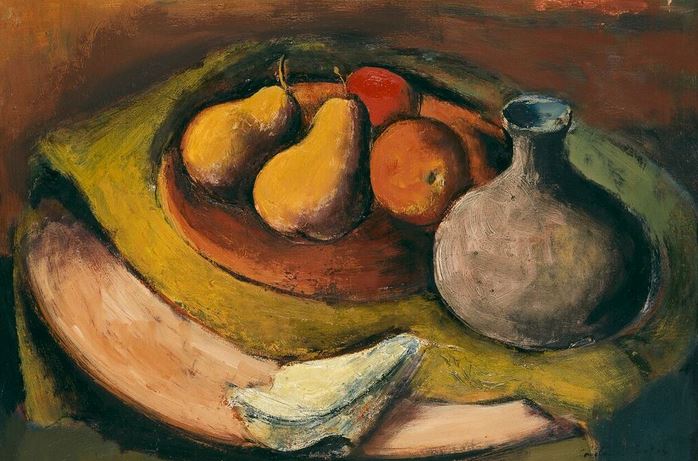
The Noble Art of Affirmation
Constance Stokes: Art & Life
by Lucilla Wyborn d’Abrera
Hill House Publishers, 2015, 234 pages, $95
 All those who take an interest in the history of art in Australia will rejoice at the appearance of this well-written, informative and sumptuously produced book on the life and work of a painter who has rightly been described by Dr Anne Summers as “one of our country’s finest artists”: Constance Stokes (left). If Stokes’s is not a name that springs immediately to mind as precisely that, it is no fault of the artist, nor of her works, but is instead due to certain vagaries of the cultural history of Australia in the twentieth century and which applied to the art of painting here especially.
All those who take an interest in the history of art in Australia will rejoice at the appearance of this well-written, informative and sumptuously produced book on the life and work of a painter who has rightly been described by Dr Anne Summers as “one of our country’s finest artists”: Constance Stokes (left). If Stokes’s is not a name that springs immediately to mind as precisely that, it is no fault of the artist, nor of her works, but is instead due to certain vagaries of the cultural history of Australia in the twentieth century and which applied to the art of painting here especially.
It is not that Constance Stokes’s paintings were not given considerable recognition in the first part of her career, say up to the 1960s. Nor was she necessarily the victim of those wearisome ideologues always ready to consign this or that painter, or indeed any other type of professional artist, to the non-status of “former persons” as in Soviet parlance. Largely, it was more the case that others attracted more and sustained attention at certain key periods of this artist’s career, which was to a major extent limited in terms of pictures during her child-rearing years. Stokes was, latterly in her career, for far too long unduly neglected and marginalised, before being periodically “re-discovered”. A similar phenomenon is familiar from the careers of certain great singers: Florence Quartararo’s for instance, and to some extent, Anita Cerquetti’s, or that of Australian-born Margherita Grandi; whose names went into comparative eclipse, only to be later acclaimed as stupendous talents, and recordings of whom now feature at the forefront of the history of singing.
This essay appears in the December edition of Quadrant.
Click here to subscribe
One may pursue the musical analogy a little further and note that Professor Joseph Burke, the distinguished occupant of the Chair of Fine Arts at the University of Melbourne in the period 1947 to 1979, described Constance Stokes’s art in terms of the “nobility of mood” which her works evoked. In his introduction to the Retrospective Exhibition of Stokes’s works held at the Swan Hill Regional Art Gallery in Victoria in 1985, he wrote:
Consider also the delight of our own eyes, not only in the controlled luxury of richly warm colours, but also in the discovery of those enfolding lines that simultaneously define contour and express volume, a sensuous pleasure that accompanies the nobility of mood. This … is not at all what might be expected from one of the most private and retiring of Australian artists, for it can be expressed through powerful thrusts and even expressive distortions of monumental shapes …
Those words from that eminent gentleman capture the essence of the gifts in Constance Stokes’s art: particular qualities of colour and of line loom large therein. Her draughtsmanship always remained superb and the colours in her works, from early to late, are remarkable.
Constance Stokes has not gone unnoticed in the annals of art history in Australia. She had significant recognition from critics and the art-buying public in her early years as a painter and as Dr Summers has noted, Stokes was selected along with prominent Australian artists including Arthur Boyd, William Dobell, Russell Drysdale, Donald Friend, Sidney Nolan, Lloyd Rees, Jean Bellette and others, to exhibit in the show of “Twelve Australian Artists” held in London during Coronation Year 1953. As well, she has been referred to in books such as Eagle and Minchin’s The George Bell School: Students, Friends and Influences (1981); whilst the references to her in the text there were not detailed and the illustrations of her work limited to only two picture photographs, that was admittedly more a history of an art school than of the many individual artists involved with it.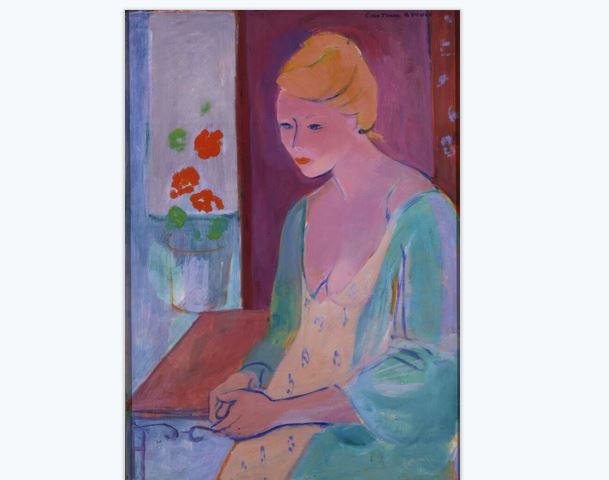
Contemplation, 1965 (private collection)
The various texts cited in the notes to the narrative in the book under review also evidence the importance of Constance Stokes and her artistic achievement in twentieth-century Australian art history and the development of art here. Chief among them hitherto was Dr Summers’s book The Lost Mother: A Story of Art and Love (2009), which did much to revive attention, not only to the artist and her works, but to their significant place in Australian art.
This new book, by the artist’s daughter Lucilla d’Abrera, goes much further and provides us with a detailed and carefully assembled account of Constance Stokes’s life, her early training and the development of her artistry and how she made a career in the art world of an earlier epoch when that was by no means an easy thing to do—especially in Australia. However, this is no mere family-based biography; it is a duly researched and very well crafted account of the artist’s personal life and artistic development, enlivened by material drawn from the Stokes’s extensive legacy of letters and diaries of her European experiences in the turbulent 1930s, after winning the NGV Travelling Scholarship in 1929. It also benefits from a helpful selection from period family photographs. In addition, included are two fine essays by Jane Clark and Felicity St John Moore, who provide detailed critical appraisals of the Stokes’s works.
Stokes was born Constance Parkin in 1906 at Miram in rural western Victoria. After schooling at the Genazzano Convent in Kew, she trained at the NGV Art School in Melbourne under L. Bernard Hall from 1925 and later at the Royal Academy of Arts in London. In 1932, she studied in Paris under André Lhote, who mentored various Australian artists. In 1933, she returned to Melbourne and married the businessman Eric Stokes. They set up home in premises in Collins Street, where she had a studio. Her work had been noticed by George Bell and by Sir Arthur Streeton, who described her Portrait of Mrs W. Mortill as a “rare attraction” and “liquid and luminous”. Stokes’s picture The Village (c. 1933–1935) now in the NGV’s collection, was exhibited in the Contemporary Art Society’s inaugural exhibition and later at the Metropolitan Museum of Art in New York. Her early exhibitions met with considerable success, both from the critical point of view and also in terms of good sales of pictures to collectors such as Keith and Elisabeth Murdoch, who provided enthusiastic encouragement for the arts in Australia.
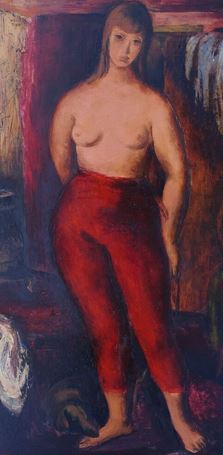 In 1940, she became part of the Melbourne Contemporary Artists exhibiting group founded by George Bell. In 1946, the art critic Alan McCulloch described works exhibited by Stokes as “rich and opulent pictures”. Of her Girl in Red Tights (c. 1948) which was included in the 1953 Coronation Exhibition, Professor Burke wrote that with it, Stokes had “announced the pursuit of the classical ideal as [her] aim … [and that the picture] with its Venetian richness of colouring, ably sustains the monumental harmony of the classical tradition”. Sir Phillip Hendy, the Director of the National Gallery in London, identified this remarkable work as “the best picture in London that week” and Sir Kenneth Clark, who had first met Constance Stokes at Melbourne on his visit there in 1949, held a luncheon in her honour at London during Coronation Year.
In 1940, she became part of the Melbourne Contemporary Artists exhibiting group founded by George Bell. In 1946, the art critic Alan McCulloch described works exhibited by Stokes as “rich and opulent pictures”. Of her Girl in Red Tights (c. 1948) which was included in the 1953 Coronation Exhibition, Professor Burke wrote that with it, Stokes had “announced the pursuit of the classical ideal as [her] aim … [and that the picture] with its Venetian richness of colouring, ably sustains the monumental harmony of the classical tradition”. Sir Phillip Hendy, the Director of the National Gallery in London, identified this remarkable work as “the best picture in London that week” and Sir Kenneth Clark, who had first met Constance Stokes at Melbourne on his visit there in 1949, held a luncheon in her honour at London during Coronation Year.
These were signal indications of Stokes’s importance in the mainstream narrative of art in Australia. Despite some noisy criticisms in Australia when the 1953 choices were announced, the roll-call of key names was not random or accidental, nor mere curatorial whimsy. It represented a considered judgment as to which artists were most important in assembling a representative offering of the best achievements in painting in Australia at that time. It must be recalled that the various festivities surrounding the Coronation of Queen Elizabeth II provided an important occasion for what we should now call the “showcasing” of cultural achievements in all of the Commonwealth countries, including Australia. Various books and articles were written in the United Kingdom on such themes, notably Ian Bevan’s edition A Sunburnt Country epitomising and sketching Australia, for the benefit of the British public and for the planners and entourage of the enormously successful Royal Tour of the Queen’s Pacific Realms in 1953 and 1954, which also provided another boost to patronage of the arts in Australia.
In 1949, Sir Kenneth Clark had already described Stokes as “the greatest draughtswoman of the century”. Yet in the art world, there are always those critics who delight in the easy quip to traduce a 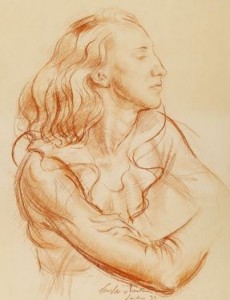 well-earned reputation. Thus, in her earlier interwar period, one critic had written that Stokes “had already [displayed] the dangerous facility of a Royal Academician”. That, of course, is precisely the sort of snide deprecation which some people applied to the works of such indubitably great artists as John Singer Sargent and Augustus John. The possession of such “facility” is no doubt partly a matter of natural talent in drawing and painting, but enhanced by formal training; yet it too often engenders a negative reaction from those who like to fancy themselves avant-garde. It ought to be recognised as a mark of distinction, not a cause for objections by onlookers who are often themselves quite incapable of such “facility”. This brings us to the vexed questions of how and why Constance Stokes’s name and achievement became obscured in the later phases of her career, even though, especially after her husband’s early death in 1962, she continued to paint and exhibit works of great beauty of line and colour.
well-earned reputation. Thus, in her earlier interwar period, one critic had written that Stokes “had already [displayed] the dangerous facility of a Royal Academician”. That, of course, is precisely the sort of snide deprecation which some people applied to the works of such indubitably great artists as John Singer Sargent and Augustus John. The possession of such “facility” is no doubt partly a matter of natural talent in drawing and painting, but enhanced by formal training; yet it too often engenders a negative reaction from those who like to fancy themselves avant-garde. It ought to be recognised as a mark of distinction, not a cause for objections by onlookers who are often themselves quite incapable of such “facility”. This brings us to the vexed questions of how and why Constance Stokes’s name and achievement became obscured in the later phases of her career, even though, especially after her husband’s early death in 1962, she continued to paint and exhibit works of great beauty of line and colour.
One way to tackle this is, as Dr Summers has noted, to trace the extent to which Stokes and her works were mentioned (or otherwise) in standard texts on the history, development and appreciation of Australian art during the twentieth century. It is telling that the late Robert Hughes’s book The Art of Australia (1966) does not make any reference to Stokes; and the Art Gallery of New South Wales has the dubious distinction of not holding in its collections any painting or drawing by Constance Stokes: a small but significant artefact, perhaps, of the traditional Sydney–Melbourne rivalry. James Gleeson’s Australian Painters (1971) omitted Stokes. Despite a very favourable review of Stokes’s solo exhibition in 1964, Bernard Smith in his major survey Australian Painting (1962) made no reference to Stokes other than his listing of the fact of her inclusion in the 1953 Coronation Exhibition in London.
Worse, as Dr Summers notes, Max Germaine’s Dictionary of Women Artists in Australia “inaccurately describes Stokes as a ‘traditional painter’” and Richard Haese, in his Rebels and Precursors “dismisse[d] her and fellow artists Isabel Tweddle and Clive Stephen as ‘technically proficient [but] never enterprising’”. Anyone familiar with the work of Tweddle, another much under-rated artist who is still not as widely known as she should be, will readily see that Haese there does not tell anything like the full story. Indeed, there are some links with Stokes’s work in the lyrical colour palette favoured by Tweddle in her still lifes, landscapes and portraits.
It was Alan McCulloch, in his influential tome Encyclopaedia of Australian Art, that vade mecum of art scholars, critics and collectors in Australia, who gave Stokes real credit for her artistic achievements and placed her role in the development of modernism in Australian art in its proper context and significance:
a leading figure in the modernist movement in Victoria, her early paintings include still life (below) and classically conceived figure group studies, as well as the open line drawings of nudes for which she is best known. Later her palette lightened, also her themes, which became more decorative.
McCulloch had praised Constance Stokes’s works as far back as 1946; and the revised edition of McCulloch’s Encyclopaedia (1994) also features an illustration of Stokes’s Two Seated Nude Figures (1958).
Professor Burke had listed Adrian Lawlor, Laurie Thomas and Patrick McCaughey as others who discerned the high quality of Stokes’s work. It should also be remarked here that Constance Stokes received scholarly published notice much earlier in her career. She was mentioned, in her then maiden name of Parkin, by William Moore in the first volume of his The Story of Australian Art (1934). Later publications listing significant Australian artists did not omit her—for example, Skinner and Kroeger’s Renniks Australian Artists in 1968 referred to Stokes’s works in “oils, ink, figures, portraits” and her painting in Victoria, England and France, her studies with Bell and at the Royal Academy and with Lhote in Paris, as well as her work being exhibited in the London Show and Venice Biennale in 1953 and inclusion in state and regional collections. Stokes’s works and activity were discussed in more detail by Janine Burke and June Helmer in scholarly books published in the 1980s.
It is odd and unfortunate that, perhaps due to the vagaries of marketing and other factors, whilst some artists such as Grace Cossington Smith have (quite rightly) been brought to wide public notice, the career of a key artist like Constance Stokes was allowed to fall into the shadows. In her, we have a  painter who played a major part in the development of Modernism in Australia, who deserves to be restored to a place of proper recognition; and Lucilla d’Abrera’s new book achieves just such a restoration.
painter who played a major part in the development of Modernism in Australia, who deserves to be restored to a place of proper recognition; and Lucilla d’Abrera’s new book achieves just such a restoration.
Constance Stokes: Art & Life is a handsome and indeed necessary addition to any good collector’s library on Australian art. In addition to the extensive, generous and well-reproduced colour plates and drawings, the layout, typography and binding of this book are a tour de force of quality, well beyond what one usually gets for its price.
In addition to the main text, the book includes as appendices two perceptive and scholarly essays on the art of Constance Stokes: “Old Masters, New Painting” by Jane Clark, and “Her Own Space” by Felicity St John Moore. These essays not only complement and extend the story of the artist’s life and work as told in Lucilla d’Abrera’s narrative, but also stand in their own right as important and well-researched accounts of key aspects of Stokes’s career. Jane Clark’s essay provides a detailed and carefully considered account of Constance Stokes’s artistic development, from the beginning of her training, through her years in London and Paris, her return to Melbourne and her 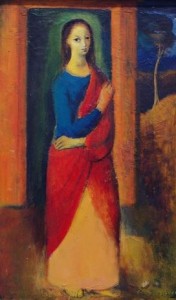 work to about 1951, and noting the several important religious works that Stokes painted, such as The Baptism (c. 1950) and The Virgin (c. 144, at right). Felicity St John Moore’s essay focuses on Stokes’ involvement with the George Bell School and in particular her drawings, but also the influence on her work of Henri Matisse, especially in her later portrait works.
work to about 1951, and noting the several important religious works that Stokes painted, such as The Baptism (c. 1950) and The Virgin (c. 144, at right). Felicity St John Moore’s essay focuses on Stokes’ involvement with the George Bell School and in particular her drawings, but also the influence on her work of Henri Matisse, especially in her later portrait works.
As well as these essays and Lucilla d’Abrera’s narrative, the book also includes detailed lists of exhibitions and acquisitions, and a bonus by way of eight pages of full colour plates of works in pastels and other media by Constance Stokes from her family’s collection, followed by a full list of paintings and drawings. Despite constant predictions of the death of the book, that publishers such as Hill House are able to provide the public with such superb volumes on art does us all a great and gracious service. This is a book to be treasured—a just tribute to an artist of the front rank, whose role as one of our leading Modernists should never be forgotten.
Dr Hassall will have further contributions on art in Quadrant in 2016.
Madam: Archbishop Fisher (July-August 2024) does not resist the attacks on his church by the political, social or scientific atheists and those who insist on not being told what to do.
Aug 29 2024
6 mins
To claim Aborigines have the world's oldest continuous culture is to misunderstand the meaning of culture, which continuously changes over time and location. For a culture not to change over time would be a reproach and certainly not a cause for celebration, for it would indicate that there had been no capacity to adapt. Clearly this has not been the case
Aug 20 2024
23 mins
A friend and longtime supporter of Quadrant, Clive James sent us a poem in 2010, which we published in our December issue. Like the Taronga Park Aquarium he recalls in its 'mocked-up sandstone cave' it's not to be forgotten
Aug 16 2024
2 mins



